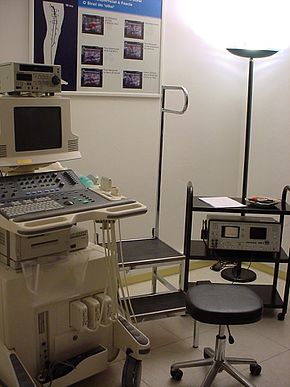| Lower limbs venous ultrasonography | |
|---|---|
 Ultrasonography equipment.
Sonographic scanner | |
| Purpose | details of anatomy, physiology and pathology of superficial veins. |
Ultrasonography of suspected or previously confirmed chronic venous insufficiency of leg veins is a risk-free, non-invasive procedure. It gives information about the anatomy, physiology and pathology of mainly superficial veins. As with heart ultrasound (echocardiography) studies, venous ultrasonography requires an understanding of hemodynamics in order to give useful examination reports. In chronic venous insufficiency, sonographic examination is of most benefit; in confirming varicose disease, making an assessment of the hemodynamics, and charting the progression of the disease and its response to treatment. It has become the reference standard for examining the condition and hemodynamics of the lower limb veins. Particular veins of the deep venous system (DVS), and the superficial venous system (SVS) are looked at. The great saphenous vein (GSV), and the small saphenous vein (SSV) are superficial veins which drain into respectively, the common femoral vein and the popliteal vein. These veins are deep veins. Perforator veins drain superficial veins into the deep veins. Three anatomic compartments are described (as networks), (N1) containing the deep veins, (N2) containing the perforator veins, and (N3) containing the superficial veins, known as the saphenous compartment. This compartmentalisation makes it easier for the examiner to systematize and map. The GSV can be located in the saphenous compartment where together with the Giacomini vein and the accessory saphenous vein (ASV) an image resembling an eye, known as the 'eye sign' can be seen. The ASV which is often responsible for varicose veins, can be located at the 'alignment sign', where it is seen to align with the femoral vessels.
On ultrasound at the saphenofemoral junction in the groin, the common femoral vein (CFV) with the GSV and the common femoral artery (CFA) create an image called the Mickey Mouse sign. The CFV represents the head, and the CFA and GSV represent the ears.[1] The examination report will include details of the deep and the superficial vein systems, and their mapping. The mapping is drawn on paper and then drawn on the patient before surgery.
The use of ultrasonography in a medical application was first used in the late 1940s in the United States. This use was soon followed in other countries with further research and development being carried out. The first report on Doppler ultrasound as a diagnostic tool for vascular disease was published in 1967–1968. Rapid advances since then in electronics, has greatly improved ultrasound transmission tomography.